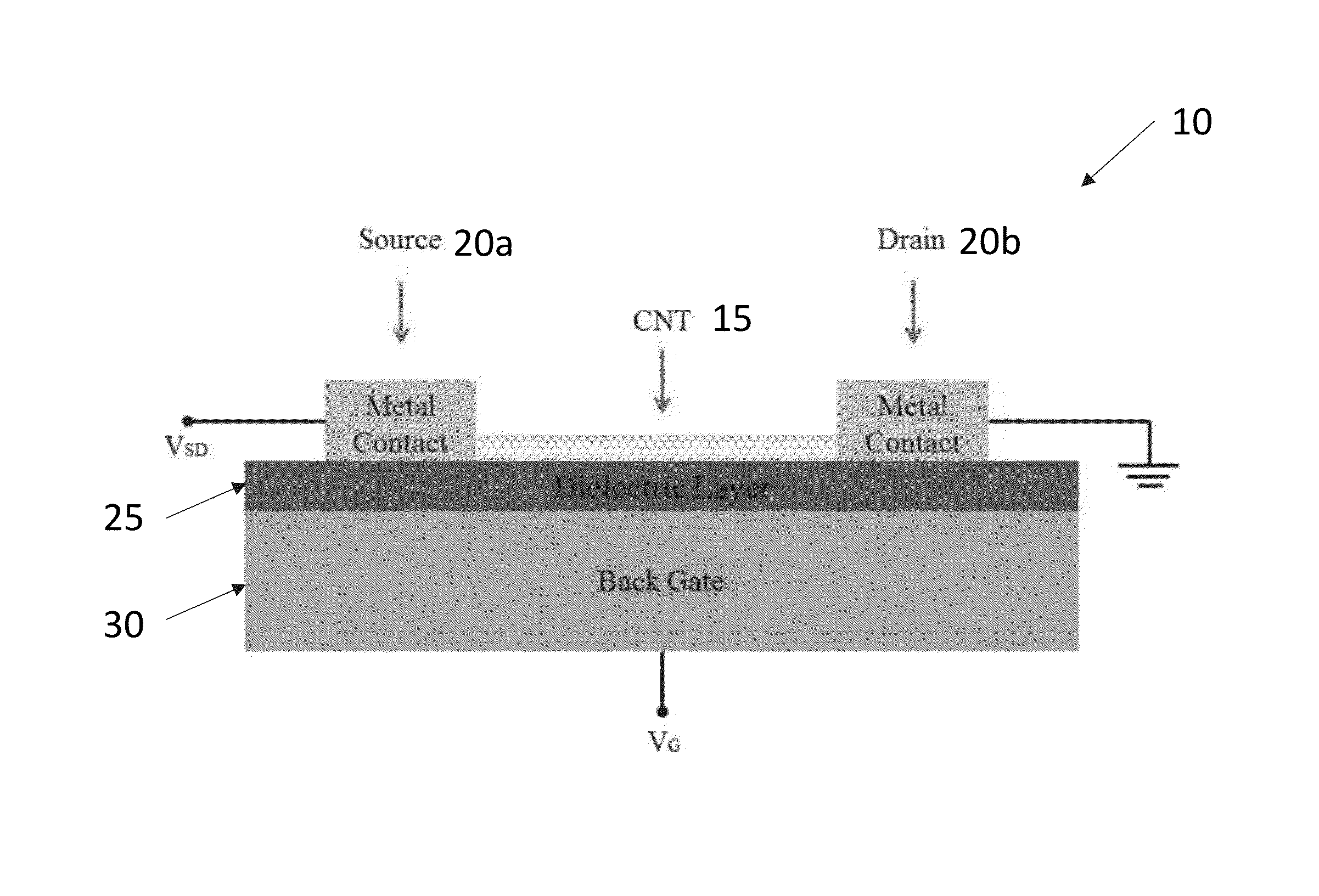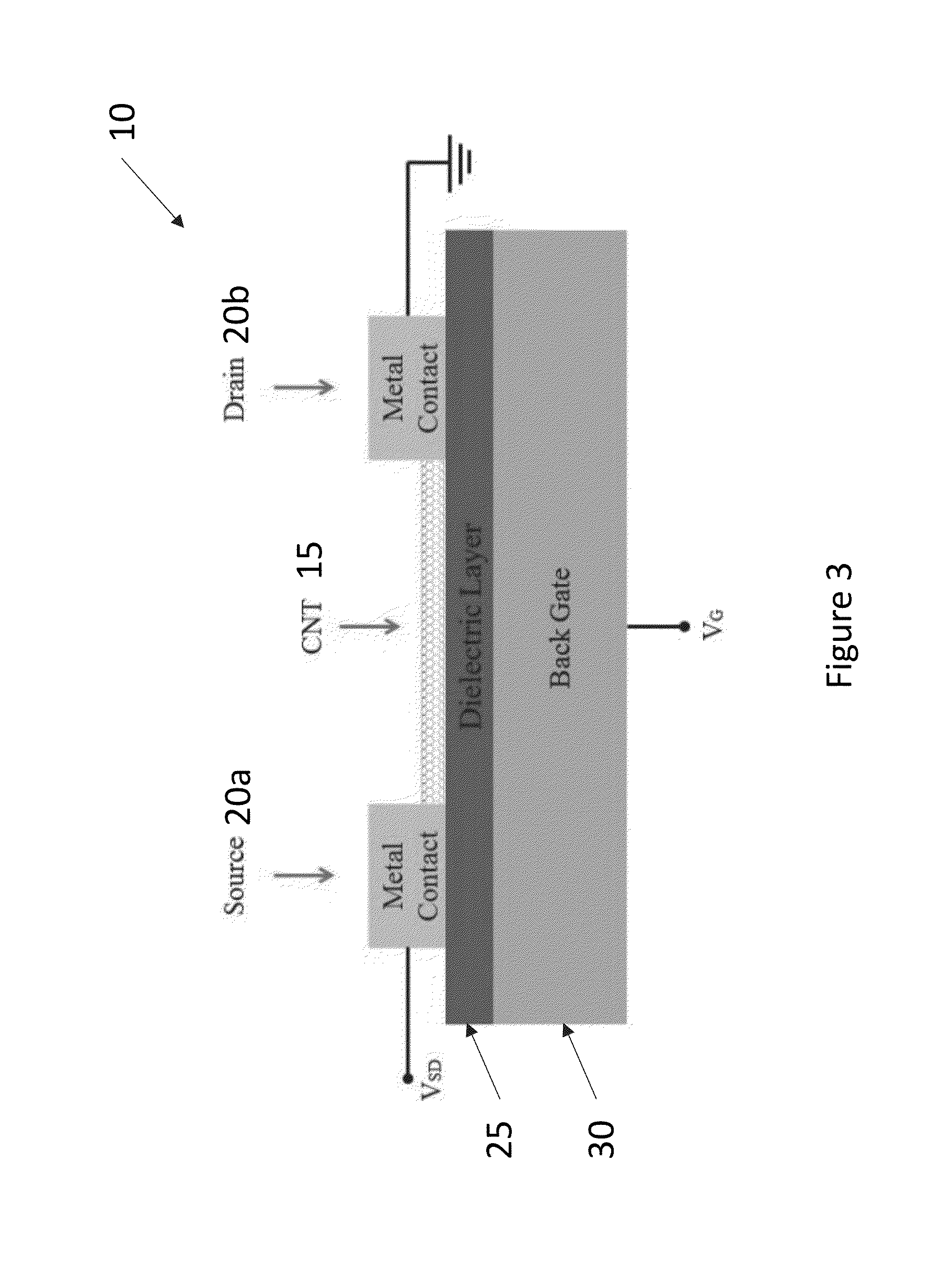Biosensor and system and process for forming
a biosensor and biosensor technology, applied in the field of biosensors and the processes for forming biosensors, can solve the problems of limited efficacy of available glucose sensor technology, insufficient supply of glucose to the brain, dangerous for people with diabetes,
- Summary
- Abstract
- Description
- Claims
- Application Information
AI Technical Summary
Benefits of technology
Problems solved by technology
Method used
Image
Examples
first embodiment
[0026]A first embodiment described herein includes a process for forming a functionalized carbon nanotube field effect transistor (CNTFET) device including site-specific nanoparticle deposition on a carbon nanotube field effect transistor (CNTFET) including one or more carbon nanotubes, a source electrode, a drain electrode, and a sacrificial electrode on a substrate with an interposed dielectric layer. The process comprises: passivating the CNTFET with a layer of Poly(methyl methacrylate) (PMMA); programming a processor of an electron-beam lithography system with a predetermined removal pattern; applying electron-beam lithography using the electron-beam lithography system to the CNTFET to remove portions of the PMMA layer and expose one or more underlying portions of the one or more carbon nanotubes and the sacrificial electrode of the CNTFET in accordance with the programmed predetermined removal pattern; applying an amount of an electrolyte solution to the CNTFET, including the e...
second embodiment
[0027]A second embodiment described herein includes a process for forming a functionalized carbon nanotube field effect transistor (CNTFET) device including site-specific nanoparticle deposition on a carbon nanotube field effect transistor (CNTFET) including one or more carbon nanotubes, a source electrode, a drain electrode, and a sacrificial electrode on a substrate with an interposed dielectric layer. The process comprises: removing portions of a protective layer covering the one or more carbon nanotubes in accordance with a predetermined removal pattern to expose one or more individual underlying portions of the one or more carbon nanotubes and to expose the sacrificial electrode of the CNTFET, wherein each of the exposed one or more individual underlying portions of the one or more carbon nanotubes has a first predetermined dimension; applying an amount of an electrolyte solution to the CNTFET, including the exposed one or more underlying portions of the one or more carbon nano...
fourth embodiment
[0029]In a fourth embodiment, a process for forming a functionalized carbon nanotube field effect transistor (CNTFET) device including site-specific nanoparticle deposition on a carbon nanotube field effect transistor (CNTFET) including one or more carbon nanotubes, a source electrode, a drain electrode, and at least a first and second sacrificial electrode on a substrate with an interposed dielectric layer, includes: removing portions of a protective layer covering the one or more carbon nanotubes in accordance with a first predetermined removal pattern to selectively expose a first individual underlying portion of the one or more carbon nanotubes and to selectively expose the first sacrificial electrode of the CNTFET; applying an amount of an electrolyte solution to the CNTFET, including the exposed first underlying portion and the exposed first sacrificial electrode; applying a first voltage to the first sacrificial electrode while grounding the source and drain electrodes; elect...
PUM
| Property | Measurement | Unit |
|---|---|---|
| thickness | aaaaa | aaaaa |
| size | aaaaa | aaaaa |
| size | aaaaa | aaaaa |
Abstract
Description
Claims
Application Information
 Login to View More
Login to View More - R&D
- Intellectual Property
- Life Sciences
- Materials
- Tech Scout
- Unparalleled Data Quality
- Higher Quality Content
- 60% Fewer Hallucinations
Browse by: Latest US Patents, China's latest patents, Technical Efficacy Thesaurus, Application Domain, Technology Topic, Popular Technical Reports.
© 2025 PatSnap. All rights reserved.Legal|Privacy policy|Modern Slavery Act Transparency Statement|Sitemap|About US| Contact US: help@patsnap.com



